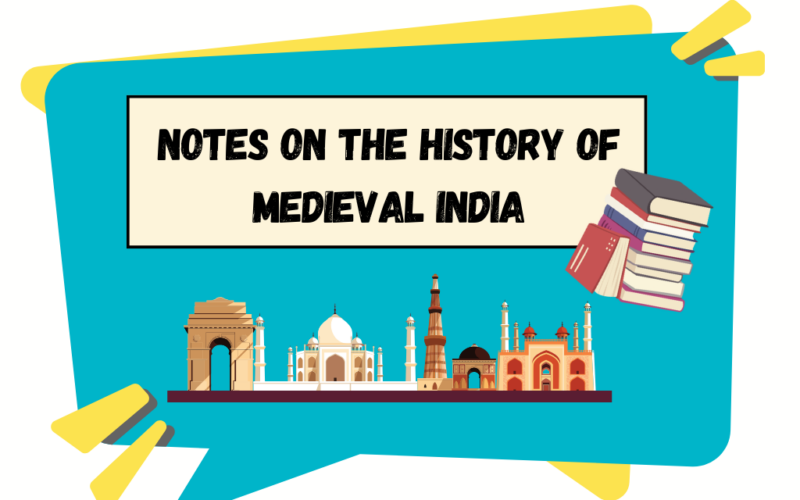The history of India is divided into 3 periods, the ancient, medieval and modern. The medieval period is one of the longest periods which also connects the other two and brings the entire history together. As this topic is an important part of the competitive exams, it is essential to know everything about it. Here is a complete blog on the history of Medieval India!
This Blog Includes:
- Important Topics in the History of Medieval India
- Kingdoms of Deccan
- Chalukyas (6th – 12th century AD)
- Early Western Chalukyas
- Later Western Chalukyas
- Eastern Chalukya
- Contributions made by the Chalukyas –
- North Indian Kingdoms
- The Rajputs
- Delhi Sultanate
- Khilji Dynasty
- Tughlaq Dynasty
- Sayyid Dynasty
- Bhakti Movement
Important Topics in the History of Medieval India
Here is a list of some of the most important topics in the history of Medieval India –
- Delhi Sultanate
- Islamic Kingdoms of India
- Kingdoms of Deccan
- North Indian Kingdoms
- Vijayanagara Empire
- Bhakti and Other cultural and religious movements
- Mughal and Sur rule and arrival of Europeans
Kingdoms of Deccan
In the medieval history of India, the Deccan Kingdoms are of great significance. Southern India is part of the Deccan or Dakshinapatha areas. The Deccan is isolated from Northern India by the Vindhya and Satpura ranges, the Narmada and Tapti rivers, and the thick woods. The Deccan portion witnessed the rise during the medieval period of the Chalukyas and the Rashtrakutas. Like the Khiljis and the Tughlaqs, this time also witnessed the expansion of the Delhi Sultanate into South India.

Chalukyas (6th – 12th century AD)
This period in the history of medieval India can be further divided into three sub-parts –
- Early Western Chalukyas
- Later Western Chalukyas
- Eastern Chalukyas
Early Western Chalukyas
- They came into power during the 6th century AD in the state of Karnataka.
- Bijapur district’s Vatapi was declared as their capital.
- Rulers of the early western Chalukyas were – Jayasimha and Ramaraya, Pulakesin I.
Also Read – Chalukya Dynasty: Founder, Rulers, Legacy and Decline
Later Western Chalukyas
Rulers of this period in the history of medieval India brought the Rashtrakuta to an end, some of the famous and renowned rulers were –
- Someshwara II
- Vikramaditya VI
- Someswara IV
Eastern Chalukya
The Eastern Chalukya was founded by Vishnu Vardhana who was the brother of Pulakesin II. One of their descendants was the Kulothunga Chola who was later crowned as a Chola ruler.
Contributions made by the Chalukyas –
- They were preachers and followers of Hinduism.
- The Aihole inscription was composed by Ravikirti a Jain who was a poet in the court of Pulakesin II.
- Chalukya rulers were some of the greatest patrons of architecture.
- This period saw the development of Telugu literature.
Must Read: Important Revolutions in India
North Indian Kingdoms
This era in the history of medieval India lies between the 8th and 18th centuries A.D. With the rule of Harsha and Pulakesin II, ancient Indian history came to an end. One of the greatest North Indian Kingdoms were The Rajputs.
The Rajputs
- Rajputs are known to be the descendants of Lord Rama or Lord Krishna.
- The Rajput period starts from 647 AD to 1200 AD, they are a part of the early medieval period.
- After the death of Harsha in the 12th century, India’s destiny lied in the hands of The Rajputs.
- Rajputs are a part of the ancient Kshatriya families and are divided into 36 clans, some of the major ones are –
- Palas of Bengal
- Rathors of Kanauj
- Paramaras of Malwa
- Senas of Bengal
- Chauhans of Delhi and Ajmer
- Solankis of Gujarat
Also Read – Rajputs History: From Origins to Dominance
Delhi Sultanate
The Delhi Sultanate period started from 1206 AD and continued till 1526 AD and it witnessed a number of dynasties and rulers, some of the major dynasties in this period of the history of medieval India are listed below –
- Khilji Dynasty
- Tughluq Dynasty
- Sayyid Dynasty
Khilji Dynasty
Under the Ilbari dynasty of Delhi, the Khiljis served. The founder of the Khilji Dynasty was Malik Firuz, who was originally named by Kaiqubad during the days of the fall of the Ilbari Dynasty as the Ariz-I-Mumalik. Two of the main rulers of this dynasty were –
- Jalal-ud-din Firoz Khilji
- Ala-ud-din Khilji

Tughlaq Dynasty
During the time of Medieval India, the Tughluq dynasty emerged and was of Turk-Indian descent. The dynasty was ruled over the Delhi Sultanate starting from 1312 till 1413. During the reign of the Tughluq dynasty, India experienced significant changes in domestic and foreign policy. Major rulers of this dynasty were –
- Ghiyas-ud-din Tughluq
- Muhammad-bin-Tughlaq
- Firoz Tughlaq
Also Read – Who was Ibn Battuta?
Sayyid Dynasty
Khizr Khan founded the Sayyid Dynasty in 1414 A.D, and when Ala-ud-din Shah was the ruler, the reign of this dynasty ended. Major rulers of this dynasty were –
- Khizr Khan – The founder of Sayyid Dynasty.
- Mubarak Shah
- Muhammad Shah
- Ala-ud-din Shah

Bhakti Movement
In the early medieval era, the Alwars and Nayanar saints of South India gave new focus and expression to Vaishnava and Shaiva devotionalism. There were twelve Alwars and 63 Nayanars, as per tradition. A central component of the Bhakti movement that began as a religious reformation in mediaeval India was the use of devotion to attain salvation. The 8th to 18th century era is dedicated to the Bhakti movement, where a number of saints (Hindu, Muslim, Sikh) emerged as the Bhakti Messiah (devotion), teaching people the transformation of life through redemption from normalcy to enlightenment.
Some of the important Bhakti Movement Saints and their contributions are –
| Saints | Contributions |
| Adi Shankaracharya | Adi Shankaracharya gave a new placement to Hinduism and followed the doctrine of Monoism |
| Ramanuja | Ramanujacharya was a preacher of Vishishtadvaita and encouraged Prabattimarga. |
| Madhavacharya | Madhavacharya was a preacher of the doctrine of dvaita. |
| Surdas | Surdas is responsible for popularizing Krishna cult in Northern India |
| Guru Nanak | Guru Nanak Dev ji was the founder of Sikh religion. |
Also Read – Bhakti and Sufi Movement: Differences and Similarities
Relevant Blogs
| Maratha Empire (1674-1818) | The Mauryan Empire (321-185 BC) |
| Kushan Dynasty | Sunga Dynasty |
| List of All the Khilji Rulers | Lodi Dynasty |
| Chola Dynasty | Gupta Empire |
| Yadava Dynasty | Hoysala Dynasty |
We hope that we have covered the important topics on the Indian History of Medieval India. If you want to know more about topics like this, then visit our general knowledge page! Alternatively, you can also read our blog on general knowledge for competitive exams! Also, you can further read about our Study Notes on the Modern History of India.

 One app for all your study abroad needs
One app for all your study abroad needs





















 45,000+ students realised their study abroad dream with us. Take the first step today.
45,000+ students realised their study abroad dream with us. Take the first step today.

